|
THE GRAND JUNCTION CANAL
A HIGHWAY
LAID WITH WATER.
PART I. ― BACKGROUND
TRANSPORT EVOLUTION
TRAVEL AND TRANSPORT IN PRE-INDUSTRIAL BRITAIN
Until well into the 19th century the best speed at which a traveller
could progress from one town to another was that of a galloping
horse, assuming of course that the highway was fit to gallop over,
which was not always the case.
The Romans thoroughly understood the value of good roads, but for
centuries after their departure their successors did not. It
was not until the end of the 17th century and the creation of the
first ‘turnpike trusts’ that some effort was made to improve the
quality of main roads by turning road construction and maintenance
into a business.[1] Trusts were authorised to raise loans for
road repairs and erect tollhouses for the collection of tolls from
road users other than pedestrians. Although turnpikes
resulted in some improvement, the problem of how to construct a
sound road remained until the end of the 18th century when the civil
engineer John Metcalf constructed roads having firm foundations and
good drainage, drainage being achieved using a smooth convex surface
(camber) that allowed rainwater to run off into roadside drains.
Metcalf’s work was developed by Thomas Telford and by John Loudon McAdam, who appreciated the importance of a hard, watertight
(‘macadamised’) road surface. However, the construction of
good main roads made slow progress ― even turnpike roads often had
poor reputations ― with most continuing to be maintained by the
parish until the Local Government Act of 1888 transferred this
responsibility to county and county borough councils.
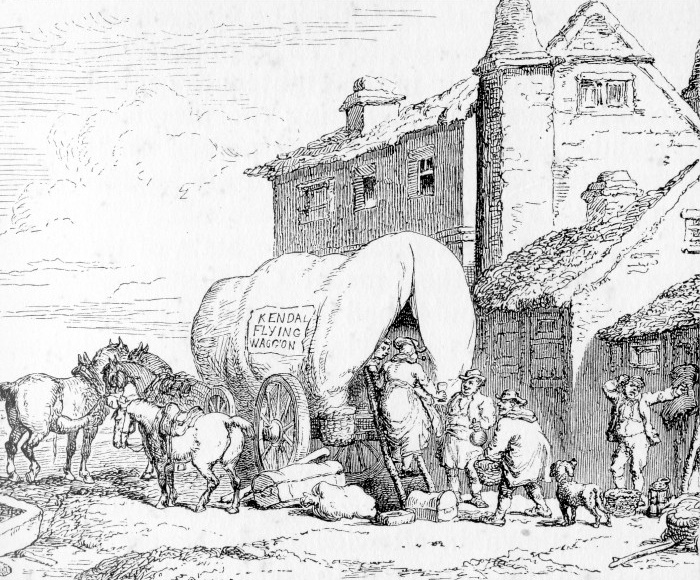
The Flying Wagon.
Many records exist of travellers through pre-industrial Britain
complaining bitterly about the appalling condition of our highways.
This is what seasoned traveller Arthur Young (1741-1820) had to say
about the state of a road in Lancashire over which he was obliged to
pass . . . .
“I know not, in the whole range of language, terms sufficiently
expressive to describe this infernal road. Let me most
seriously caution all travellers who may accidentally propose to
travel this terrible country, to avoid it as they would the devil;
for a thousand to one they break their necks or their limbs by
overthrows or breakings down. They will meet with ruts, which
I actually measured, four feet deep, and floating with mud, only
from a wet summer; what, therefore, must it be after winter?”
Rather than being uncommon, Young’s experience was typical.
Britain’s roads were sometimes impassable in summer and often so in
winter. That doyen of Victorian biographers, Samuel Smiles, in
his biography on the civil engineer Thomas Telford, related another
unfortunate traveller’s experience . . . .
“As late as 1736 we find Lord Hervey, writing from Kensington,
complaining that ‘the road between this place and London is grown so
infamously bad that we live here in the same solitude as we would do
if cast on a rock in the middle of the ocean; and all the Londoners
tell us that there is between them and us an impassable gulf of
mud.’ Nor was the mud any respecter of persons; for we are
informed that the carriage of Queen Caroline could not, in bad
weather, be dragged from St. James's Palace to Kensington in less
than two hours, and occasionally the royal coach stuck fast in a
rut, or was even capsized in the mud.”
Such was the state of our roads for the traveller, but when goods
were to be moved the problem in obtaining any passage, let alone a
swift one ― other than by navigable river or the sea ― became even
more difficult. Transport of goods by wagon over distance was
impractical due to the ploughed-up and often water-logged condition
of the highway, and thus packhorses were the norm. Although
limited in the load they could carry [2] and the speed at which they
could travel, packhorse trains were heavily used in the transport of
goods, even surviving in isolated areas until well into the 19th
century.
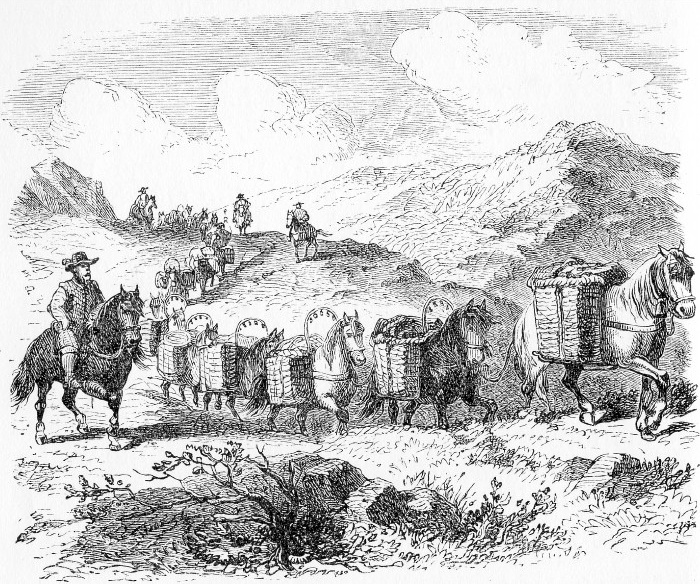
A pack-horse convoy. |
――――♦――――
|
THE IMPACT OF THE INDUSTRIAL REVOLUTION
From the middle of the 18th century Britain entered a period of
rapid technological and social change that continued for the next
century. Aptly named the ‘Industrial Revolution’, this era was
to have a marked impact on almost every aspect of our lives and to a
far greater extent than in any previous period in history.
The factors that led to the Industrial Revolution are complex, but
they can be summed up as a rapid development and bringing together
of new ideas, methods and machinery. Amongst the latter were
mechanical inventions for streamlining the manufacture of textiles,
which were to lead to the factory system and the growth of our
manufacturing towns and cities. James Watt’s condensing steam
engine was, quite literally, a driver for change, for it provided
mines with effective pumping equipment, thereby allowing lower-level
seams to be worked, and factories with a reliable source of power free from the vagaries
of the mill stream or river.
The Industrial Revolution was to bring about major changes in
agriculture, mining and manufacturing and with them a demand for the
transport of raw materials and finished goods more quickly, cheaply
and reliably than was possible over the highways and packhorse roads
of the age. The outcome was a further revolution ― in methods of transport.
――――♦――――
THE COMING OF THE CANALS
|
 |
|
Depiction of a flyboat. |
|
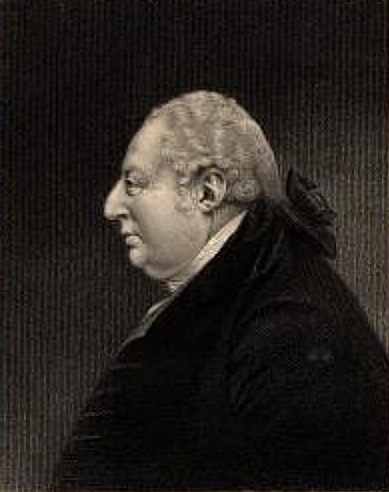 |
|
Francis Egerton, 3rd Duke
of Bridgewater (1736-1803),
canal promoter.
Died
to-day Francis Egerton third and last Duke of
Bridgewater, Father of Inland Navigation. The late Duke
was very eccentric through having being jilted by a
famous beauty in his youth. He refused to allow a woman
to wait upon him, delighted in the destruction of
flowers, took snuff and smoked inordinately, and dressed
like Dr. Johnson. Through having spent such vast sums on
constructing canals in this country, he became so
impoverished that Ashridge House had fallen into decay
to such an extent that in places the roof had become
open to the sky. Having amassed considerable wealth
through the great success of the inland waterways, it
was the Duke's intention to rebuild Ashridge House on a
very grand scale, but he died before achieving his
ambition.
Tring
Vestry Minutes, 8th March 1803. |
Canals marked a huge leap forward in
both transport and civil
engineering. They became our first transport network, ending
decisively the situation in which heavy materials in quantity, such
as coal and iron, could only be moved inland for short distances,
mainly along navigable rivers; and until the arrival of public
railways, which soon captured the trade, canal ‘flyboats’ [3] also provided
comparatively quick transit for high value goods and a comfortable journey for passengers,
although passenger carrying on canals was never common.
Although theirs was not the earliest canal to be built in the
British Isles, [4] much of the credit for the birth and execution of the
idea must go to the 3rd Duke of Bridgewater, [5] to his land agent
and engineer, John
Gilbert (1724-95), who supervised much of the work, and to his canal engineer
James Brindley (1716-72). Between them they constructed a waterway whose
commercial success was to give rise to our canal network.
The Duke’s father, Scroop Egerton (1st Duke of Bridgewater,
1681-1744), was involved in a scheme to use canals to
transport coal from Lancashire into Manchester, but nothing came of
it, possibly due to the difficulty of raising adequate finance.
As a young man, the 3rd Duke had seen and been impressed by the
Canal du Midi in southern France. [6] Knowing his father’s ideas
on canals and seeing the French canal possibly spawned in his mind
the idea of using canal navigation for his own purposes, but credit
for the idea might equally rest with John Gilbert.
In 1759, the Duke obtained a private Act of Parliament to build a canal
to convey coal from his mines at Worsley in Lancashire to
Manchester, and he commissioned James Brindley as
engineer. Brindley, an accomplished millwright by trade, had
previously made a preliminary survey for the Trent and Mersey Canal.
When he was appointed engineer to the Bridgewater Canal,
construction was already underway. Brindley immediately
revised the route to Manchester, later extending the canal to the
Mersey, which it entered through a long flight of locks at Runcorn.
|
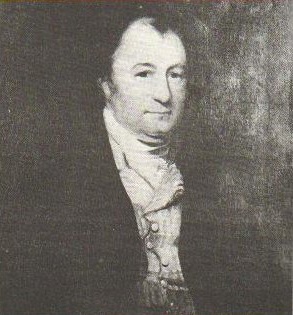 |
|
John Gilbert
(1724-95), engineer
and land
agent. |
|
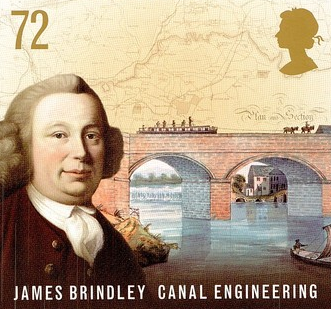 |
|
James Brindley
(1716-72), canal engineer. |
The Bridgewater Canal opened in 1761. Generally accepted as
our first true canal, it was a startling success. The
improvement that it brought about in the conveyance of coal to
Manchester halved its price. However, the canal did not yield
its full potential until the development of James Watt’s condensing
steam-engine some years later and its widespread application to
manufacturing, which rendered a cheap and abundant supply of coal
vital to Manchester’s commercial success. The advantage of
canal-borne transport then became clear; the average packhorse could
be loaded to ⅛ ton; a horse could haul a wagon loaded to ⅝ ton over
an unmade road or, if on a macadamised surface (where they existed),
2 tons; but a horse could haul a canal barge loaded to 30 tons.
The success of the Bridgewater Canal proved the viability of
canal transport and industrialists elsewhere became interested in
canals as a means of improving transport communications
and increasing their sales. In Staffordshire, the famous
potter Josiah Wedgwood saw in canals an opportunity to convey cargoes of clay to his factory doors and to transport his fragile
finished goods to market, and he became a strong supporter of what
became the Trent and Mersey Canal. [7] During the 1790s, a period
known as the ‘canal mania’ set in with huge sums being invested in
canal building, sometimes by investors who saw an opportunity for
earning high rates of return from canal tolls and sometimes by
speculators intent on making a killing from the rapidly rising
prices of canal shares. Although many schemes came to nothing,
between 1760 and 1829 [8] over 100 canals were built and the system
expanded to over 4,000 miles in length.
Parliament did not, however, mandate constructional standards for
canals. The outcome was that canals varied in width and depth,
their locks also varied in the size of the lock chamber, and other
restrictions combined to prevent the canal system from operating as
a true national network, unlike the railways that
were to follow. Despite this drawback, canals provided a
great leap forward in transport communications. In particular,
cheap coal became widely available and inland coalfields expanded
massively to supply the demand of heavy industries in inland areas,
most notably the Potteries and the industrial Midlands. |

|
He will be ever
memorable among ‘those who were honoured
in their generations, and were the glory of their
times.’
Impulit ille rates ubi duxit aratra colonus
[He sent barges across the
fields the farmer formerly tilled]
The Duke of Bridewater's tomb, church of
St Peter & St Paul,
Little Gaddesden, Hertfordshire.
|
――――♦――――
|
THE GRAND JUNCTION CANAL
The Grand Junction Canal grew out of a need for a better waterway
than that provided by the Oxford Canal and the Thames, to link the
industrial Midlands with London, which besides being a considerable
market in its own right was also one of our principal seaports.
|
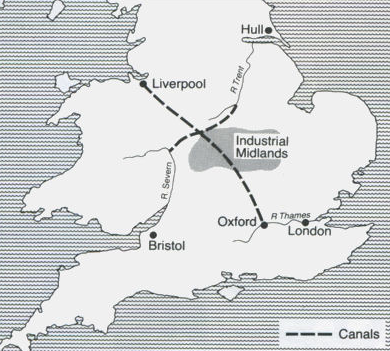 |
|
Brindley’s ‘Grand Cross’, a system of
canals
linking London, Liverpool, Bristol and Hull. |
The Oxford Canal was designed by James Brindley as a constituent of
his grand plan for a waterway ‘cross’ to link the rivers Thames,
Mersey, Trent and Severn, and hence the ports of London, Liverpool,
Hull and Bristol. Its 78 miles extend from the
outskirts of Coventry, via Rugby and Banbury to Oxford, where it
connects with the River Thames. Construction commenced in
1769, but shortage of funds hampered progress resulting in the canal
being opened in stages. Eventually completed in 1790 by
James Barnes (a Banbury brewer who was to play an important role in
future events), during the following fifteen years the Oxford Canal
became one of the most important and profitable transport links in
Britain, carrying much of the commercial traffic between London and
the Midlands. Cargoes of coal from the Coventry
coalfields produced some two thirds of its revenue, but it also
carried stone, agricultural products and other goods.
In common with other early canals, the Oxford Canal suffered the
drawback of the limited civil engineering knowledge of its time.
Built originally to follow the contours of the land, this approach ― much favoured by Brindley
― avoided the need for expensive
cuttings, embankments, aqueducts and tunnels. The outcome was
a meandering canal that provided many opportunities for building wharves along its length, but at the cost of increased
distance; and with the Industrial Revolution's growing commercial pressures,
increased distance meant increased time, and time cost money. Having reached the Thames, there was
then a lengthy journey between Oxford and the Metropolis along a
river that was at times prone to difficult navigation through
drought on the one hand and flooding on the other. Thus, there
arose a business case for a shorter more reliable route between the
industrial Midlands and the marketplace of London:
“It was in the year 1792 that this undertaking first had its
origin. In the beginning of that year the Marquis of
Buckingham instructed Mr. Barnes, the eminent engineer, to make a
survey of the country between Braunston, in Northamptonshire, the
place where the Oxford Canal has its junction with the present
canal, and the Thames near London, in order to mark out a line of
canal, whereby the circuitous course by the Thames Navigation from
Oxford might be avoided, and the transit of goods to the metropolis
accelerated. Mr. Barnes's survey was laid before a public
meeting at Stoney-Stratford, in June of the above year, when his
plan was approved, and a committee formed for carrying on the
scheme.”
Navigable Rivers, Canals and Railways of Great
Britain: Joseph Priestley (1831)
In fact the route was surveyed twice. The first was that
undertaken by Barnes, but the better-established canal engineer
William Jessop was then asked to resurvey the route chosen by
Barnes; he found little to change. The outcome was a Bill for
the Grand Junction Canal, which passed Parliament on 30th April
1793. William Jessop was appointed Engineer-in-Chief and
Barnes Resident Engineer. In practice this meant that Jessop’s
role was that of formulating or approving plans, giving advice and exercising
oversight, while Barnes and his assistants managed the day-to-day
construction.
Much of the new canal was opened by 1800, but excavating the long
Blisworth Tunnel (3,076 yards) met with severe engineering
difficulties resulting in the section from Blisworth to
Stoke Bruerne remaining unfinished until 1805.
When complete, the Grand Junction Canal shortened the earlier
route between London and the Midlands by some 60 miles and not
being prone to the vagaries of the Thames, it also provided a more
reliable waterway. As a result the new canal thrived: in 1810
it carried 343,560 tons of goods through London, with roughly equal
amounts into and out of the capital.
――――♦――――
THE
COMING OF THE RAILWAYS
While the canal network was extending its tentacles through
industrial Britain, a new generation of transport communication was being
conceived that would quickly overtake the canals as Victorian Britain’s
principal mode of transport.
|
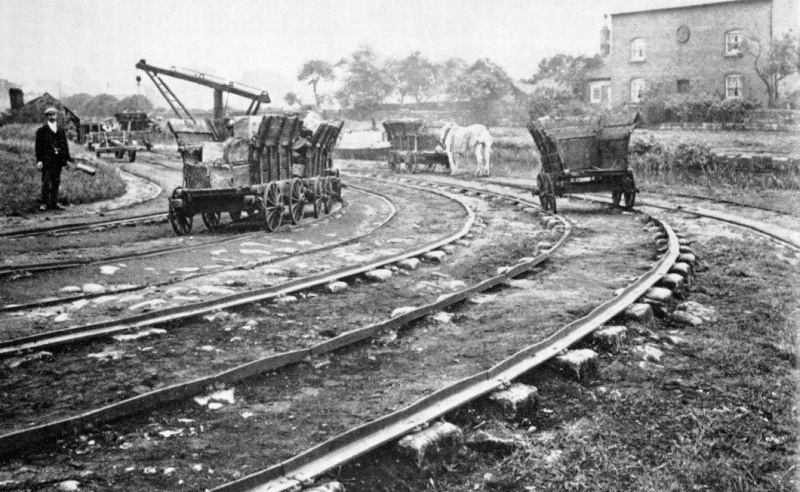
A horse-operated
plateway.
Built by Benjamin Outram, this 5-mile long line carried
coal from
Denby
Hall Colliery to the Derby Canal.
It operated
between 1795 and 1908.
|
Industrial tramways had been in use for many years preceding the
building of Brindley’s first canals. They probably grew out of
the realisation that a horse could draw a far greater weight of
merchandise over a smooth and level track built of wooden planks
laid in parallel, end-to-end:
“The use of wooden rails gradually extended, and they were laid
down between most of the collieries on the Tyne and the places at
which the coal was shipped. Roger North, in 1676, found the
practice had become extensively adopted, and he speaks of the large
sums then paid for way-leave - that is, the permission granted by
the owners of lands lying between the coal-pits and the river-side
to lay down a tram-way for the purpose of connecting the one with
the other.
A century later, Arthur Young observed that not only had these roads
become greatly multiplied, but formidable works had been constructed
to carry them along upon the same level. ‘The coal wagon-roads
from the pits to the water,’ he says, ‘are great works, carried over
all sorts of inequalities of ground, so far as the distance of nine
or ten miles. The tracks of the wheels are marked with pieces
of wood let into the road for the wheels of the wagons to run on, by
which one horse is enabled to draw, and that with ease, fifty or
sixty bushels of coals.’ . . . . In these rude wooden tracks we find
the germ of the modern railroad.”
The Life of George Stephenson,
Samuel Smiles (1857)
|
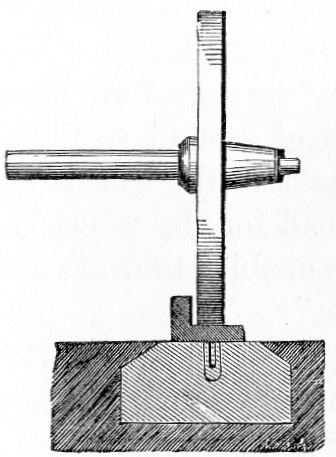 |
|
Early iron plate railway line. |
It was next discovered that this crude form of track would wear
better if reinforced with iron plates, from which it was a simple
transition, as manufacturing methods improved, to construct a track
entirely of iron plate, usually ‘L’-shaped, which would contain the
wagon wheels with the additional advantage that the wagons could
also be used on ordinary roads. However, plates were prone to
break, and so emerged the forerunners of the strong ‘edge rails’,
requiring flanged wheels, that are used on our railways today.
Again, Samuel Smiles . . . .
“In 1789, Mr. William Jessop constructed a railway at
Loughborough, in Leicestershire, and there introduced the cast-iron
edge-rail, with flanges cast upon the tire of the wagon-wheels to
keep them on the track, instead of having the margin or flange cast
upon the rail itself; and this plan was shortly after adopted in
other places. In 1800, Mr. Benjamin Outram, of Little Eaton,
Derbyshire, used stone props instead of timber for supporting the
ends or joinings of the rails. Thus the use of railroads, in various
forms, gradually extended, until they became generally adopted in
the mining districts.”
In common with the first canals, tramways were mainly constructed by
mine and quarry owners to convey their goods to wharfs for shipment
by water. The fact that they were built for horse-drawn wagons
and dimensioned accordingly, is thought to be behind the modern 4 ft
8½" ‘standard gauge’.
This was the stage that railways had reached when the next important
development took place, attempts to replace the motive power
provided by a horse or mule with the steam engine. |
――――♦――――
|
THE RISE OF RAILWAYS, THE DECLINE OF
CANALS
By the close of the 18th century, Watt’s steam engines had achieved
such a degree of mechanical sophistication that they had become the
indispensible workhorses of our growing industrial economy. [9] But
Watt had never shown any interest in applying his inventions to
transportation, perhaps realising that the form in which he had
developed the steam engine precluded it. Because of the danger
of exploding boilers, which were then in a primitive stage of
development, and ongoing problems with steam leaks, he shied away
from the use of high pressure steam. Instead, his engines used
steam near to atmospheric pressure, which meant they needed large
diameter pistons to produce the required thrust supplemented by a
condenser ― itself quite massive ― to create a vacuum on the low
pressure side of the piston. This made such engines unsuitable
for anything but marine use, where size and weight were of less
importance than in a road or rail vehicle.
By comparison, a high-pressure steam engine derives substantial
thrust directly from the pressure of steam in the boiler, thereby
enabling smaller diameter pistons to deliver the same thrust as in a
Watt engine of comparable power. This results in a smaller and
lighter engine. Furthermore, as most of the pressure
difference that drives the piston is provided by the high boiler
pressure, the low-pressure side of the piston may be left at
atmospheric pressure ― in other words, the condenser needed to
generate a vacuum in a Watt engine may be dispensed with.
The Cornish mining engineer and inventor, Richard Trevithick
(1771-1833), is credited with the first use of high-pressure steam
and its application to railway use. The world’s first
steam-hauled railway journey took place on 21st February 1804, when
Trevithick’s steam locomotive hauled a train comprising 10 tons of
iron, five wagons and 70 men a distance of 9¾ miles at an average
speed of about 2½ mph along the tramway of the Penydarren Ironworks,
near Merthyr Tydfil. But Trevithick’s locomotive was too heavy
for the tramway, damaging its cast iron plates, and no further use
was made of it for that purpose. [10]
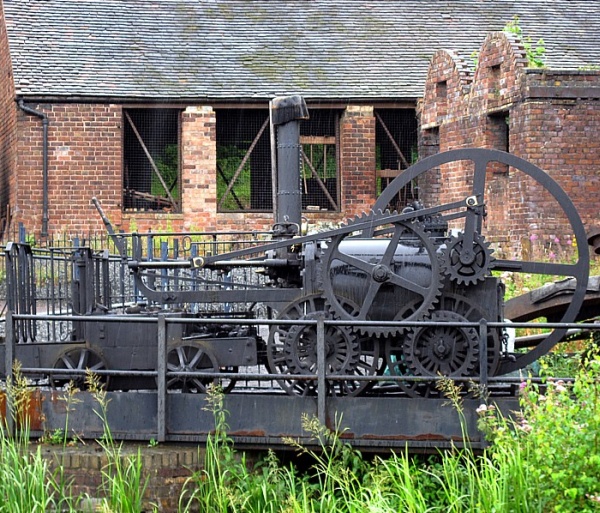
A reconstruction of Trevithick’s locomotive ―
Ironbridge Gorge Museum.
A locomotive to a design by Trevithick was later built at the Wylam
Colliery at Newcastle. Although it also proved too heavy for
the colliery’s wooden track, it did inspire others to build
locomotives of their own design. Among them was George
Stephenson, a self-taught and accomplished mechanical engineer who,
in 1814, built his first railway locomotive. Not only did he
go on to improve the design of the steam locomotive and of the iron
rails on which they ran, but he also became an accomplished civil
engineer.
|
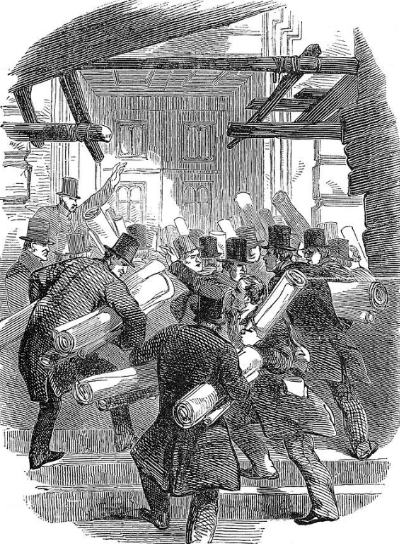 |
|
The ‘Railway Mania’,
1845.
Deposits of railway plans with the Board of Trade.
There
had
been a similar period of ‘Canal Mania’
during the early
1790s. |
In 1822, Stephenson built his first railway, an eight-mile line
between Hetton Colliery and a landing stage on the River Wear at
Sunderland. It was also the first railway designed to be
operated by mechanical means, partly by cable-haulage using
stationary steam engines and partly by steam locomotives.
However, it was the railways that followed for which George
Stephenson is best known; the 26 mile Stockton & Darlington Railway,
opened in 1825, introduced the concept of a public railway for the
transport of passengers and goods, and the use of steam locomotives;
the 35 mile Liverpool & Manchester Railway opened five years later
was the world’s first purpose-built steam railway.
The Stockton & Darlington and the Liverpool & Manchester railways
were a great success. During the 1830s and especially the
1840s, a period known as the ‘Railway Mania’, many public railways
were built, among them the London & Birmingham Railway. By
1838 ― the year in which the London & Birmingham Railway was
completed ― Nicholas Wood was able to state, with confidence, that the
rapid strides then being made in railway engineering would soon render our
quiescent canals, obsolete:
“Canals ever since their adoption have undergone little or no
change; some trivial improvements may have been effected in the
manner of passing boats from one level to another and light boats
have been applied for the conveyance of passengers; but in their
general economy, they may be said to have remained stationary.
Their nature almost prohibits the application of mechanical power,
to advantage in the conveyance of goods and passengers upon them;
and they have not therefore partaken of the benefits which other
arts have derived from mechanical science.
The reverse of this is the case with railroads; their nature
admits of the almost unrestricted application of mechanical power
upon them and their utility has been correspondingly increased.
No wonder, then, that canals, which at one time were unquestionably
superior to railroads, in general economy, by remaining in a state
of quiescence, should at some period or other be surpassed by the
latter, which have been daily and progressively improving, and that
time has arrived.”
A Practical Treatise on Rail-roads, and Interior
Communication in General. Nicholas Wood
(1838)
This period marked the zenith of the canal network, with about 4,000
miles of canals in operation. From then on, the railways
gradually won over the canal’s trade, for not only could they carry
more but could do so quicker than the walking pace of a horse-drawn
canal boat. They were also less affected by the adversities of
the weather in the form of icing and drought.
In order to compete, canal companies were forced
to make
substantial reductions to their rates of toll. But revenues
and dividends
fell, and many sold out to a competing railway, which,
having acquired their business, then let the waterway fall into
disrepair ― such was the fate of the Kennet & Avon Canal
following the opening of the Great Western Railway in 1841.
Other once important canals, such as the Thames & Severn and the
Wilts & Berks, fell
gradually into dereliction and were filled in.
By the time of the 1968 Transport Act ― the first legislation to
recognise its leisure potential ― the 4,000 mile network had shrunk to
its nadir of some
1,400 miles of navigable waterways. Commercial traffic had fallen to negligible
levels, but leisure boating was by then on the increase and during
the following decades canals gradually acquired a new purpose in
life. Today, some sections are busier during the summer months
than they ever were in their industrial heyday.
|
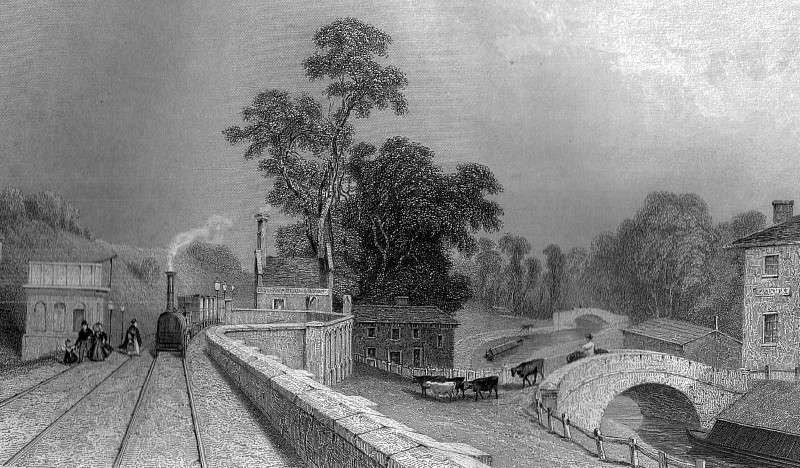
The former London & Birmingham
Railway station at Berkhamsted (1838).
The Grand Junction
Canal is to the right.
|
The Grand Junction Canal shared the fortunes of the canal network in
general. Its trade was badly damaged by the railways, for
although the tonnage it carried remained fairly buoyant for many
years, it did not share in the greatly increased volume of freight carried by rail, while what it did carry was at greatly reduced
rates. In 1929 its owners amalgamated with other canals to
form the Grand Union Canal Company, but the new company continued to
experience mixed fortunes, its trade not being helped by WWII.
Whether nationalisation in 1948 was of benefit or not is a matter of
conjecture; suffice it to say that the waterway survived into the
age of leisure boating and a sustainable future. |
[Chapter II.]
――――♦――――
FOOTNOTES
|
1. |
Each turnpike trust was created under its own Act of Parliament, as
were the canals and railways that came later. |
|
2. |
Depending on the size of animal, about 250 to 300 lbs (110 to 140
kgs) per horse in balanced panniers. |
|
3. |
Narrowboats with covered seating for passengers, usually towed by
two horses. They had right of way over other canal traffic and could
also bypass queues at lock gates. The term ass also applied to
cargo-carrying narrow boats that operated an express service by
travelling non-stop, day and night, to their destination. |
|
4. |
Earlier canals were the Exeter Canal (1567), the Newry Canal (1741),
and the Sankey Brook Navigation, later to become the St. Helens
Canal (1757). |
|
5. |
Francis, 3rd Duke of Bridgewater (1736-1803), Scroop Egerton’s
youngest son. |
|
6. |
Opened in 1681, this 150-mile canal together with other waterways
links the Atlantic with the Mediterranean. The continentals were far
ahead of Britain in their development of inland waterways. |
|
7. |
The Trent and Mersey Canal was authorised by an Act of Parliament in
1766, its first sod being cut by Josiah Wedgwood in July that year
at Middleport. |
|
8. |
During the early 1790s, there was a dramatic rise in the number of
schemes promoted, and this period has become known as that of ‘canal
mania‘ (there was a similar speculative frenzy in railways shares
during the 1840s). The number of canals authorised by Act of
Parliament in 1790 was one, in 1793 it was twenty. The capital
authorised in 1790 was £90,000 (£8.7 million as of 2012), but this
had risen to £2,824,700 (£266 million as of 2012) by 1793.
After 1829 there was only one important canal Act, that authorising
the Manchester Ship Canal (1884). |
|
9. |
In 1800, following the expiry of Boulton & Watt’s patents, other
engine-builders entered the field. |
|
10. |
The locomotive finished its life as a stationary engine driving
hammers. |
――――♦―――― |